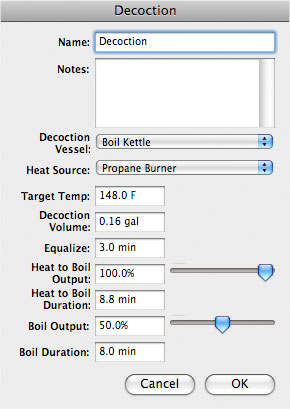Decoction
Decoction is a way to raise mash temperature by removing a portion of the mash, heating it,and returning it to the mash vessel.
Editor
The various fields in the "Decoction" edit box are used for the following purposes:
|
Usage Notes
The volume needed to decoct is calculated based on other variables in your mash schedule, such as the infusion rate in your mash-in step (recommended 1.25-1.33 qts/lb). Basically, for a decoction step you need to select a vessel that you will be using for the decoction heating and a heat source, such as a burner that has been calibrated for heat output. Put the temperature that you want your mash to be when you return the decocted portion back to the mash-tun; this allows BeerTools Pro to calculate the decoction volume that you will remove for your decoction step. You can adjust the Heat to Boil Output slider to determine how strong your flame will be during heating; this determines how many minutes it will take you to get to a boil. Finally, you set how long you will be boiling the decocted volume to account for evaporation from your kettle.
Background
Decocting is a technique developed by old style European brewers for brewing lager beers. Historically, it became practical for several reasons. First, precise analytical equipment for monitoring temperatures did not exist, so basing mash methods from simple proportional removals of the mash that were boiled and returned to the main mash vessel allowed fairly precise and consistent mash results. Water was often quite basic, so an acid rest was needed to help acidify the mash, and this acid rest worked well in a decoction schedule. Also, grain production was not as advanced as it is today, so grains lacked the high degree of in-kernel modification that we have today. This meant that enzymes were unavailable in the grains, so a protein rest to allow the production of proteases was necessary. Finally, greater malt complexity was achieved in their beers through the production of melanoidins during the decoction process.
Nowadays, most German breweries no longer decoct, but use infusion mashing with melanoidin production being achieved through advances in their wort boiling equipment. For the homebrewer, decoction can be used to create greater flavor complexity in their lager beers while using traditional equipment. Boiling the grains for a short time, e.g., 10 minutes, will reduce the size and complexity of malt starch and protein molecules and make them more convertable into sugars for the yeast to consume, as well as producing a clearer beer. It may also raise your effiency. Additionally, decoction can give the beer slightly more color through kettle caramelization and a deeper malt flavor from the production of melanoidins from the Maillard reaction.
With highly modified malts such as those in production worldwide nowadays, only a protein rest and a single decoction of 33-40% of the heaviest mash with a raise to saccharification temperature is needed. This allows for a fairly simple mash schedule that requires about the same time as does an infusion mash schedule.
Example Procedure
After a 5-minute protein rest at approximately 130ºF, pull the decoction amount using a strainer to get the thickest portion of the mash with only enough liquid to prevent scorching, but not so much liquid as to cover the grains. Bring the decocted portion to 150ºF over ten minutes, then to 167ºF over 10-15 minutes, and finally to a boil. Stir constantly during heating and boiling and use a relatively low flame to avoid scorching. After 5-20+ minutes of boiling and constant stirring, depending on the degree of darkening, caramelization, and melanoidin complexity you desire, return the decocted portion to the mash to raise the mash to saccharification temperature. After 15 minutes at saccharification rest, begin testing for starch conversion in preparation for your sparge/separation.
Example
http://www.beertoolspro.com/images/btp-icon.png GW_Premium_Pils_DblD
